Perfect for those with sensitive skin, this homemade glycerin soap recipe makes a hard bar of soap that lathers nicely while gently cleansing and moisturizing your skin.
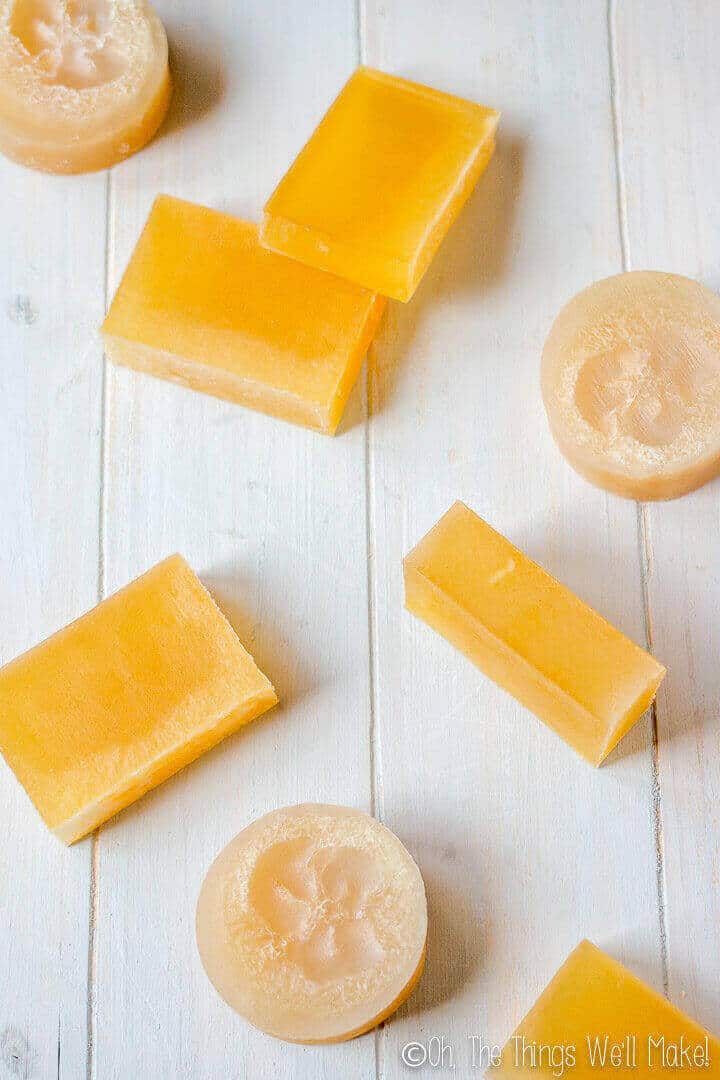
What is glycerin soap?
It sounds like an easy question, but there is really a bit of confusion about what should be called glycerin soap.
When most people think of glycerin soap, they think of translucent soaps. Many think of the translucent melt and pour soaps that can be melted down to make easy, customizable soaps. (Although not all melt and pour soaps are translucent, of course).
What most people don’t know is that there is glycerin in all soap because it is a byproduct of the soap making process.
The difference between translucent “glycerin” soaps and other more opaque soaps with glycerin in them, is that the glycerin soaps have been cooked with certain solvents like sugar, alcohol, and, well, more glycerin, to help make the soap crystals small so that light can pass through. (It’s the soap crystals that reflect light back at our eyes, making soap opaque).
Glycerin soap benefits
Glycerin is a humectant, meaning that it helps retain, or reduce the loss of, moisture.
What’s special about glycerin, though, compared to some other humectants, is that it is an endogenous humectant, meaning we have it naturally in our skin. Glycerin has been shown to help restore moisture and elasticity in the stratum corneum layer of our skin, helping to restore the barrier that protects us.
Interestingly enough, even after you stop using glycerin topically, it can continue to help form a barrier to help prevent moisture loss for up to 2 weeks.
Glycerin soaps are thought to be milder and gentler on the skin. While that probably depends on each particular recipe or soap, I’ve found that this soap has worked well on my son who has sensitive skin with atopic dermatitis. (That said, I still use soaps, or other washing products like gels, sparingly on his skin, and most days only rinse the majority of his skin with water.)
I find this to be a great overall soap for face and body, and I like how it helps reduce acne on my skin.
Watch how I make glycerin soap
The Glycerin Soap Making Process
Making a translucent glycerin soap is really a two part process.
First, you have to make the soap, using a hot process method. (I use my slow cooker which works perfectly for both parts of the process.)
After you have made your soap, you need to dissolve the soap crystals to help allow the light to pass through the soap, making it translucent. To do that, you will use a combination of several different “solvents.”
On my first two attempts, I didn’t spend a lot of time trying to dissolve the crystals. I wasn’t careful to keep the slow cooker well sealed, and I didn’t leave the solvents to work longer, or add more of them, to try to get a more translucent soap.
If getting a more translucent soap is important to you, I’ve given you a range of different solvent values for you to experiment with. I chose to add an amount somewhere in the middle of the given range of each particular solvent. You may want to try adding a smaller amount, and increase, as needed, until your soap gets more translucent. Using a stronger alcohol will also probably help you get a clearer soap.
If you’re really picky about getting translucent soap, I’d suggest reading the book, Making Transparent Soap: The Art Of Crafting, Molding, Scenting & Coloring by Catherine Failor. Her techniques are the ones that most people follow when making both translucent solid soaps and translucent liquid soaps. She has another book about Making Natural Liquid Soaps. If you’re interested in making liquid soaps, I have a couple of liquid soap recipes up on the blog. (You can choose to make a liquid castile soap, or a liquid coconut oil soap, or make both and combine them to get the best of both worlds.)
Choosing oils for a glycerin soap recipe
Because we are going to be using solvents to dissolve some of the soap crystals, it’s best to use oils that make a harder bar of soap. This will help ensure you’ll still end up with a hard, long lasting bar of soap despite the solvent process.
In general, oils that are solid at room temperature tend to make harder bars of soap. (Olive oil can also make a hard bar of soap, but it usually requires a long curing process to get it to harden.) Tallow and coconut oil are great oils for this type of recipe; not only because they make a nice hard bar of soap, but they are also said to be good for making a translucent, rather than cloudy, glycerin soap.
Castor oil is another common oil used in translucent soap making, not because it’s a solid oil that makes a hard bar of soap (because it isn’t, of course), but because castor oil is said to be somewhat of a solvent on its own.
Even after using the solvents, this recipe made very hard bars of soap, and I really love the way it lathers. The coconut oil adds to the cleaning factor of the soap and helps make a bubbly lather. The castor oil helps stabilize that lather. This was the first time I used tallow for making soap because it’s not very easy to find here. (I wanted to make my own, but couldn’t get any butchers to save beef fat for me for rendering tallow.) I have to say that I really love it, and plan on using it more often.
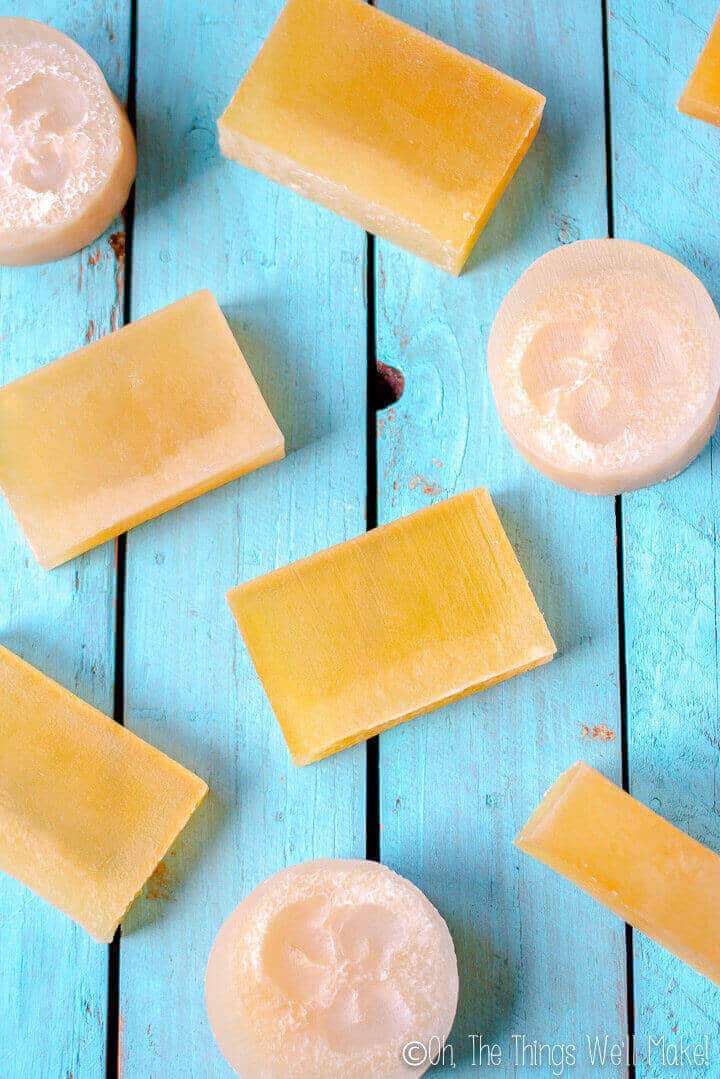
Choosing an alcohol as a solvent
I would have loved to use a consumable alcohol without any added scents or ingredients like Everclear, but I wasn’t able to find anything like that here.
Funny story…
I actually went to the supermarket with my mother-in-law and bought some 70% absinthe because it was the only drinkable alcohol I could find over 50% here in Spain. I was slightly embarrassed buying it, and felt the need to say that it was for making soap. In the end, I felt bad about using an expensive alcohol in my experiments with making a translucent soap, and wasn’t sure how the green coloring would affect the color of my final soap. (I wanted to see what I’d end up with without adding anything at all to it.)
I decided to use some 70% denatured alcohol instead. I was worried about it leaving an unusual scent to my soap, but honestly I don’t notice any off putting fragrances from the alcohol, despite my having forgotten to add any essential oils in the end for fragrance.
I think next time I’d try with a stronger alcohol to see if my soap turns out more translucent. If anybody gives a 96% alcohol, or something similar, a try, I’d love to hear how it goes!
I now have been left with a completely full bottle of absinthe at my house, if anybody wants to come for a party. (Just kidding about the second part.)
Superfatting glycerin soaps
Because excess oils can make for a cloudy soap, I chose not to superfat this soap. (Superfatting is when you add more oils to the soap than what are needed to react with the amount of lye used. Some unreacted oils remain in the soap, and can leave a hydrating film on your skin when you use the soap.)
The excess glycerin in this soap helps compensate and acts as the leftover emollient that helps make a moisturizing soap. I used the same thought process when making my liquid castile soap and liquid coconut oil soap, and find that both are very mild for use on face and body.
Now that I’ve been using this glycerin soap for awhile, I definitely don’t think it’s missing anything, and love it just the way it is. That said, you could always try adding slightly more oil if you prefer to superfat the soap.
Glycerin soap recipe
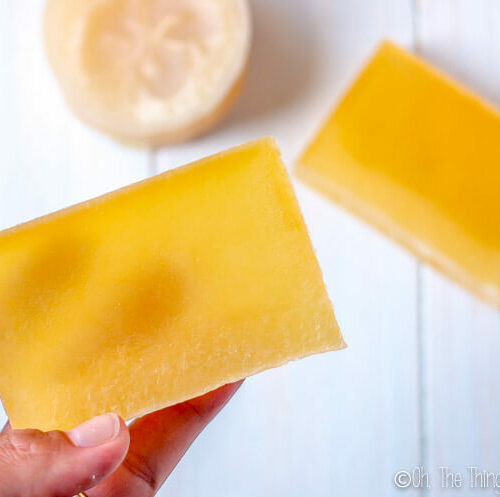
Homemade Glycerin Soap Recipe (From Scratch)
Makes around 8 bars of soap.
Materials
For the soap
- 304 g distilled water
- 117.7 g lye NaOH
- 440 g tallow
- 200 g castor oil
- 160 g coconut oil
Solvents
- 120 g glycerin Between 98g and 147g
- 300 g 70º alcohol Between 275g and 321g
- 90 g sugar Between 73g and 110g
- 180 g distilled water Between 147g and 244g
Instructions
Make the soap.
- Weigh out the lye in a small, non-metal bowl.
- Weigh out the distilled water in another, larger, non metal bowl.
- In a well ventilated area, carefully pout the lye into the container with the distilled water. You should wear gloves and goggles to protect your eyes and hands. Stir the lye into the water until it is dissolved. The mixture will heat up and get cloudy at first, but will clear up and cool down with time.
- Leave the lye mixture to cool while you weigh out the oils. I find that the easiest way is to place the bowl on a digital scale, tare it, add an oil to the bowl until you reach the right weight. You then tare again before carefully adding the next oil, and between each addition.
- Add the oils to a slow cooker on low heat, and stir them together well. Allow any solid oils like the tallow to melt.
- Carefully add the lye mixture to the melted oils, and gently stir them together. Once the lye solution is fully incorporated into the oils, you can begin to blend them together with an immersion blender.
- Blend with the immersion blender until the mixture thickens to trace. Once the mixture has reached trace, place the lid on the slow cooker and allow the soap mixture to cook for several hours (around 3) until it starts to get transparent.
- You have now made a hot process soap.
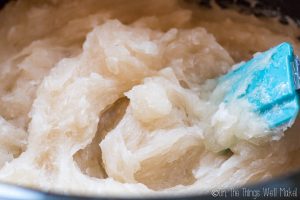
Use the solvents to make it translucent.
- Weigh out the alcohol and the glycerin. You will be mixing them together and adding them to your soap. I would have liked to use a high proof alcohol like Everclear, but couldn’t find anything like that here in Spain. I ended up using a 70º denatured alcohol. they say that if you use a higher concentration of alcohol, that it will do a better job of making the soap more transparent. (Perhaps next time I’ll try with a 90+% denatured alcohol. Rubbing alcohol is said to leave an unpleasant scent behind, but I haven’t tried it to verify the difference.)
- Pour the alcohol and glycerin mixture into the soap. You’ll probably end up with chunks of soap floating in the liquid. Try to break them up as best as you can. (I used my immersion blender to break up the chunks and fully incorporate the alcohol and glycerin into the soap. Work in a well-ventilated area for this step and be careful not to have any open flames in the area. (You should always be careful when heating high percentages of alcohol.)
- Cover the crock pot, sealing it as best you can so that the alcohol doesn’t evaporate. (If it evaporates too quickly, it won’t be able to work its magic on the soap.)
If you really have your heart set on making a translucent soap, you should seal your crock pot with some sort of plastic wrap before placing the lid on top. I didn’t have any on hand, and wasn’t really too concerned about making a fully transparent soap, so I just used the regular lid of my crock pot. - Allow the soap to cook, covered and sealed, for around 30 minutes.
- Meanwhile, make your sugar syrup. Weigh out the sugar and water and mix them together in a saucepan over low to medium heat until the sugar has completely dissolved. Remove it from the heat.
- Once the 30 minutes has passed, you can begin to add the sugar solution to the soap. Gently mix it in, trying not to move the soap too much so as not to form a lot of foam or bubbles.
- At this point, you can begin to test the soap for translucence. It will look translucent to the eye, but as it cools, it will become more opaque. The way most people check is by freezing a glass, and adding a small amount of soap to the bottom of the glass to cool it. Keep in mind that you are using a very thin layer of soap, and that when you have a thicker layer it won’t be as translucent.
- To try to get a more translucent soap, you can continue to cook the soap, adding in small amounts of the various solvents and checking the translucence with the frozen glass. (To be honest, I didn’t bother, and just added the sugar, and went right to pouring the soap into the mold. Perhaps next time I’ll try for a more translucent soap, and will give you my tips for what works best.)
- At this point, you can add in any fragrances or colorings. The nice thing about this soap is that because it has been cooking for so long, and has completed the saponification (soap making) phase, you can even use food coloring to color your soaps. You won’t have to worry about the lye reacting with the colorants and changing them as often happens when adding things to cold process soaps.
- Clear the foam off the soap, and carefully pour the soap into your soap molds. Try to be gentle at this stage as any movement can cause foaming of the soap, which will lead to a more opaque soap. (I wasn’t very careful, and my soaps have a more transparent layer on the bottom, with a thin layer that is more opaque at the top, where the bubbly soap settled before hardening.)
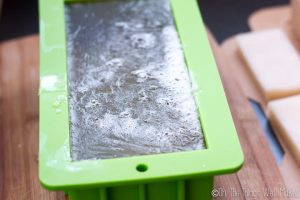
- You can skim the foam off and pour it into small soap molds. They will make a more opaque soap that will work just as well as the rest of the soap.
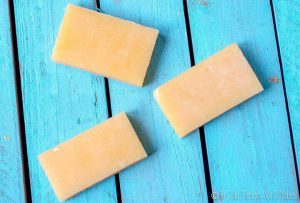
- Allow the soap to set undisturbed overnight.
- The next morning, check the soap for hardness. If it is hard enough, unmold the soap and cut it into bars as needed.
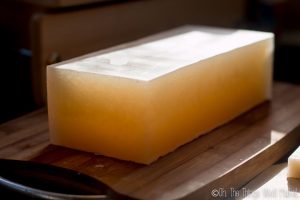
- Allow your soap to cure and dry for several weeks. This is best done by separating the soaps to allow for air flow over them. It’s a good idea to rotate the soaps occasionally so that all sides dry at the same rate. The curing process will allow it to harden and finish any remaining chemical processes to make for a better soap.
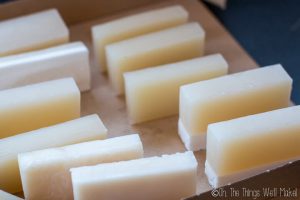
My first experience making glycerin soap
The first time I tried to make a glycerin soap, I decided to try using a new wooden soap mold for my newly made soap. I should have experimented with a soap that was easier and quicker to make like my easy, beginner soap.
What happened?
The mold began to leak, and I ended up with my soap solution all over the counter. I scraped up some of it, and tried pouring it into another mold, but by that point I had a lot of parts that were hardening up and floating in the melted soap mixture. I decided that I was going to use my immersion blender to smooth out the mixture before pouring it back into the other mold.
The result?
Because I didn’t let the mixture settle again, I ended up with a more cloudy soap. The soap started to settle on its own leaving a clearer, harder bar of soap on the bottom, and a foamier, opaque soap on top.
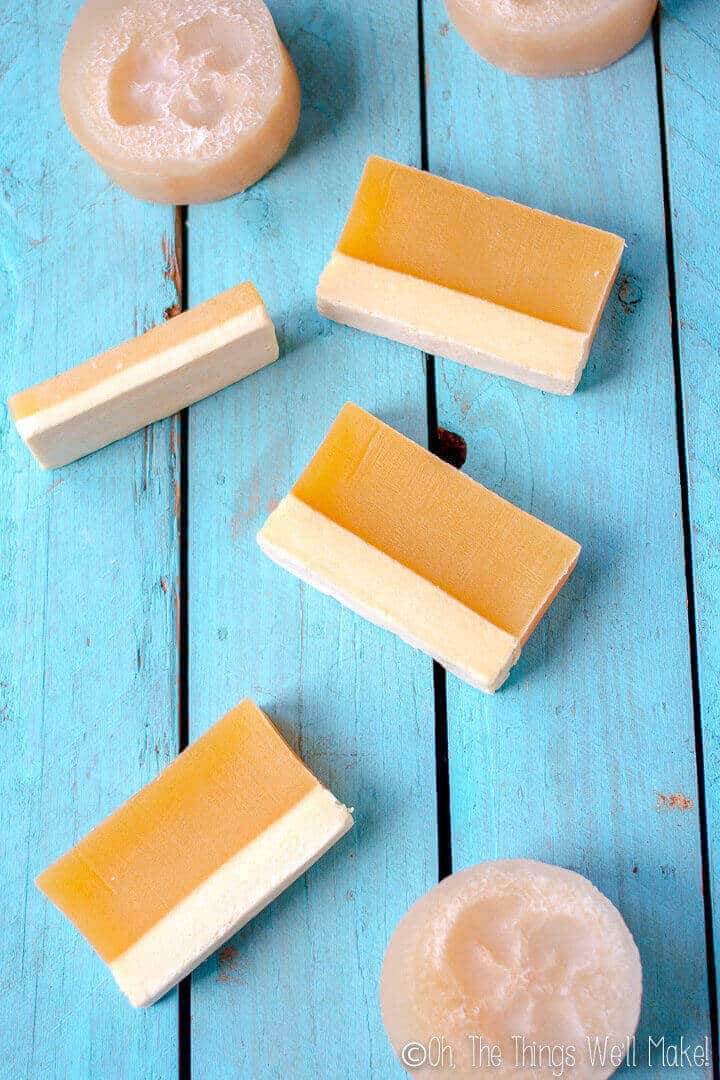
What did I learn?
It’s just as important to be careful how you handle the soap when pouring into the molds. You want to be gentle and not incorporate a lot of air into the mixture. That is, unless you are going for this lemon merengue pie look to your soap! (I have to admit that it is kind of cool. The foamy layer is very soft, and almost like a marshmallow.)
Making a loofah soap
I decided to use the translucency of this soap to my advantage, and made loofah soaps. The loofah serves as a gentle, natural exfoliant for bathing.
To make a loofah soap, you can use PVC piping as your soap mold. If you have a PVC pipe cap, you can seal off one end with one of those. If not, you can seal off the end with some heavy plastic and rubber bands.
Add the loofah to the pvc pipe and weigh it down with something. (I used a spoon.)
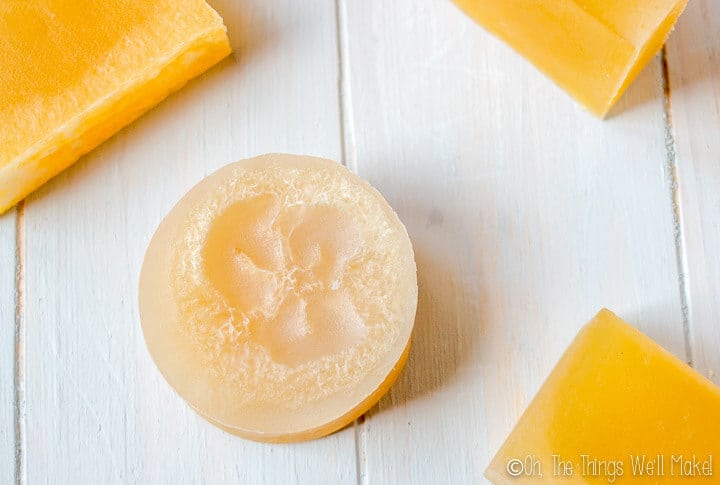
Once in place, gently pour the soap into the pipe over the loofah.
When the soap has hardened, the easiest way to pull the soap from the mold is to put the pipe into the freezer for at least half an hour. Not only will this help solidify the soap, but it will slightly reduce its size long enough to help you push the soap out of the mold.
Carefully cut the soap into round bars and allow them to cure like you would any other bar of soap.
I’m sure somebody will ask me why the loofah soaps stayed white, while the other soaps turned yellow after during the curing process…
I wish I had an answer. I will say that they were from the same batch, and I didn’t add any colorants or any different ingredients to one versus the other. I poured the bar soaps first, and then filled up the pvc mold for the loofah soaps. If anybody has any ideas about why they aren’t the same color, I’d love to hear them!
 Español
Español
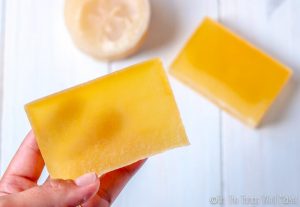
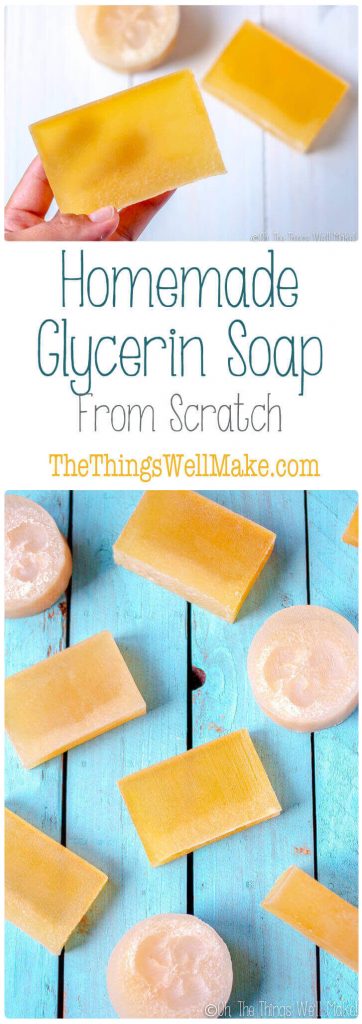
 Healthy Paleo Red Soda (Red Pop)
Healthy Paleo Red Soda (Red Pop)
Sushma
Hi Tracy, thank you for the recipe. Can this soap be made without using tallow?
Tracy Ariza, DDS
Hi Sushma,
You could sub it for something like lard, but you’d have to run it through a lye calculator to make sure the amount of lye doesn’t change. (I have a post about how to use a lye calculator. I didn’t superfat this soap because I didn’t want it cloudy and it has so much glycerin that it’s already very mild.)
That said, I have a recipe up already for a vegan glycerin soap which doesn’t use any animal fats.
Anna-Rose
Hi! What size PVC did you use and how many bars were you able to make from it?
Tracy Ariza, DDS
Hi Anna-Rose,
I used a regular loaf pan silicone mold for my soap. It depends on how you cut them, but I generally get around 10 bars from it.
REGINA LEASE
When can I add honey? Usually it is added at trace.
Tracy Ariza, DDS
Hi Regina,
Are you trying to use honey in place of the sugar syrup?
That’s when I’d try adding something like that.
Regina Lease, RN
I used the honey instead of sugar. It worked out awesome. Not translucent but the moisture it providers is, wow. Only soap I have used my first batch was ready.
Tracy Ariza, DDS
Awesome! I’m so happy to hear it worked out!
Nicoline Zeeman
Thank you for the resep
Tracy Ariza, DDS
You’re welcome!
Hadi
Hi, what is the reason of Whiting of glycerin soap? temperature or …?
Tracy Ariza, DDS
Hi Hadi,
I’m not sure I understand the question. Did you make this and get white spots somewhere?
Alicia Copa
How is this soap yellow? And should I be stirring the soap so it doesn’t “burn” as your recipe calls for a 3 HR cook? Also have you ever tried making a rebatch into a translucent soap? I’m sure the hardness of the resulting bar would depend on the original oils. I’m just trying to use up the great amount of unsellable bars and/or scraps. Thanks for all the tips! Alicia
Tracy Ariza, DDS
Hi Alicia,
I think it’s due to the animal fats when cooked or aged. It actually ages into a darker amber color. I’ll add photos of how it ages when I get to updating this post. (I’m slowly making my way through the whole blog.)
Yes, you can occasionally stir it, but it’s not really necessary on low heat to worry about it much. Too much stirring can make it cloudier.
I tried making transparent soap last year during our lockdown. I got a really transparent one, but as it aged, it turned translucent and more and more opaque. It was colorless at first, but then also aged more amber.
I haven’t rebatched soaps in that way, but I’ve read of people who have. I’d start with hard bars, of course, for the best results. I think it would work fine, though.
Fernando
Helloo, can I use potassium hydroxide (KOH) instead of NaOH?
Tracy Ariza, DDS
Hi Fernando,
KOH wouldn’t really work in this recipe. It’s more for making liquid soap pastes. It would give you a soft product, and in this case we want a really hard bar because the solvents will remove part of the structure.
I have plenty of liquid soap recipes that use KOH, but it really wouldn’t work for this recipe.
Eliza
Hi,
Can I use Isopropyl alcohol in glycerin soap recipe, please?
Thank you.
Tracy Ariza, DDS
Hi Eliza,
I’d imagine that it would work, but I’ve heard that it can leave a scent that some find unpleasant/overpowering. I haven’t tried it, though, so I don’t know for sure if that’s true.
Sarah
Do I use glycerin soap base and vegetable glycerin together? If so, what is the ratio?
Tracy Ariza, DDS
Hi Sarah,
I’m not sure I understand the question. This recipe is for making a glycerin soap yourself, from scratch. It doesn’t use any glycerin soap base.
It does add vegetable glycerin as one of the ingredients.
Mary A. Unruh
How do you get the conversion to ounces and tablespoons . Do you have the breakdown?
Does the oil and lye need to be 100 degrees each before adding the lye water to the oil mixture?
Tracy Ariza, DDS
Hi Mary,
No, I just add it all to the slow cooker on low setting and mix it there.
If you click on “convert units” under the ingredients within the recipe card, it will convert to ounces for you, if you prefer. (Those are weight ounces, though, and not fluid ounces.)
Sanjeewa chaminda
Thank you
Belinda Foley
Hi Tracy,
I just want to thank you for a great recipe. We just had a sheep killed and I had a heap of tallow so I was looking for a good tallow recipe. I had plenty of glycerine and 90% alcohol from all the hand sanitiser I’ve been making. I substituted the sugar for honey and used lemongrass essential oil, it turned out perfect first time. I did half of the batch with loofah and half in moulds and they are brilliant.
I plan on making this regularly, thanks again.
Tracy Ariza, DDS
Hi Belinda,
Thanks so much for letting me know! I’m so happy to hear it worked out for you!
It’s also one of my favorites!
José Araújo Silva
Amei seu artigo e suas dicas. Vou elaborar as receitas e tenho certeza do sucesso!
Becky
Hello Belinda. How did you do the conversion of sugar to honey?
Ty
Becky
Regina Lease
I used the same at for honey that was used for sugar. Soap takes longer to harden but is awesome. I used propolis infused evoo and made an antibacterial that moisturizes. Thank you for getting me started.
Regina Lease
Belinda
How much honey did you use and did you processed after the alcohol solvent mix as the recipe states?